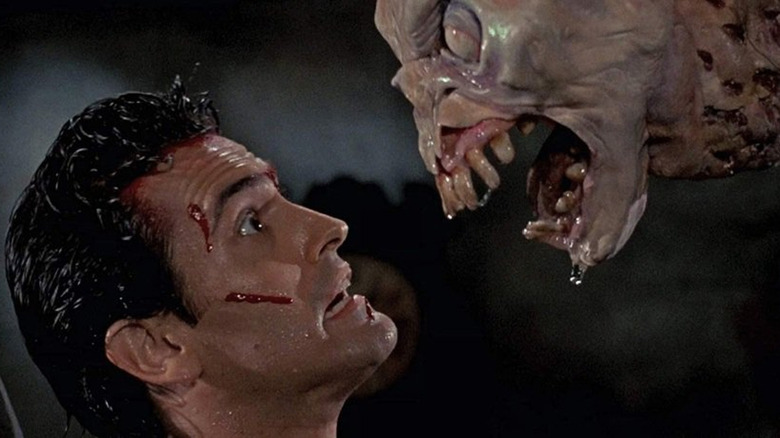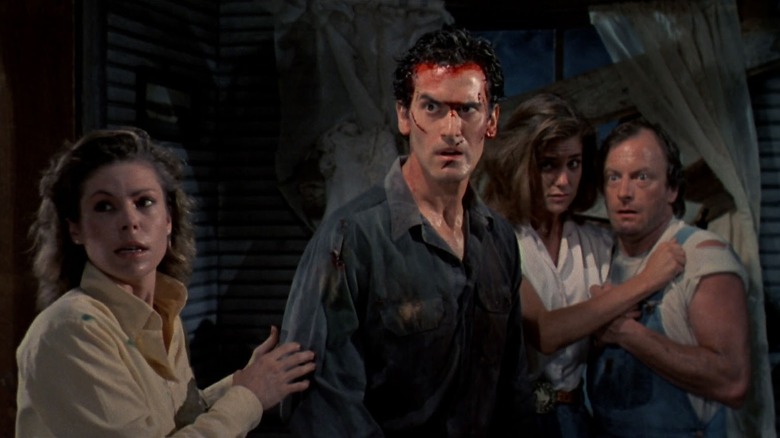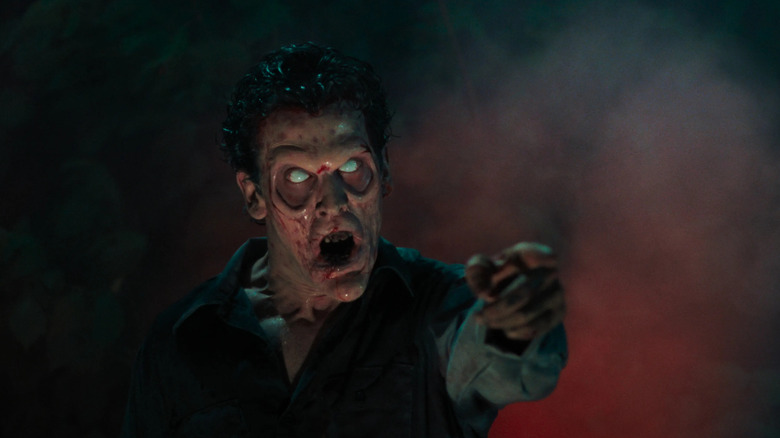Why Evil Dead II Couldn't Use Footage From Its Own Franchise
In the marketing for the notorious 1981 horror film "The Evil Dead," director Sam Raimi skewed happily away from modesty, describing his film as "The ultimate experience in grueling terror." As there would be two sequels, it proved to be the antepenultimate experience in grueling terror.
Given the size and power of the cult behind it, it seems almost churlish to put a film like "Evil Dead II" (called "Evil Dead 2: Dead By Dawn" on the posters) into an introductory context. "Evil Dead II" remains one of the finest horror comedies cinema has yet offered, presenting extreme horror visuals (severed hands, gushing blood, zombie girlfriends, basement monsters) with the slapstick timing of Buster Keaton or the Three Stooges. "Evil Dead II" has long been standard viewing for any ninth grade would-be horror fanatic, eager to chuckle at death, and persists at midnight screenings the world over.
Raimi and his crew famously made the "Evil Dead" movies on the cheap. The budget on the original was reported to be a mere $375,000. "Evil Dead II," a much slicker production and more or less a remake of the original, still only topped off at a mere $3.5 million. The distribution of "The Evil Dead" was just as scattered and haphazard as its production, and it made its way to multiple international markets through multiple individually negotiated deals. Even Raimi didn't know the fineries of how his movie made its way around the world.
And when it came time to insert some footage from the original film into "Evil Dead II," as Raimi described in Bill Warren's indispensable 2001 book "The Evil Dead Companion," the director was at a loss.
Irvin Shapiro
Irvin Shapiro is a name that may not be well-known to the average filmgoer, but will be familiar to those who know a little bit about the history of international film distribution. Shapiro, one of the founders of the Cannes Film Festival, was responsible for scouring up interesting or important European films and finding theatrical and home video rights in the United States. Without Shapiro, American audiences would not have seen Sergei Eistenstein's "Battleship Potemkin," Robert Weine's "The Cabinet of Dr. Caligari," Jean Renoir's "The Grand Illusion," or Jean-Luc Godard's fathomlessly influential "Breathless." He worked with Stanley Kubrick, George A. Romero, and Martin Scorsese. The story goes that Shapiro first suggested the title "The Evil Dead" to Raimi.
When Raimi was making "Evil Dead II," he wanted to save a little time. Rather than provide a dialogue-heavy exposition dump explaining the events of the first film, he wanted to merely cut in a few select scenes, constructing a brief, handy flashback. But as Raimi himself explained in "The Evil Dead Companion," the distribution rights had been scattered to the four winds by Shapiro:
"We tried to get the rights to the footage from Evil Dead to use at the beginning of 'Evil Dead II.' Unfortunately, because the picture was sold by Irvin Shapiro to so many different countries, and different distributors in each country, we would have had to go to each one — there were probably around fifty — and gotten clearances to use it in their territory. It was a very weird situation — some of the distributors had even gone out of business."
So that was that. No one knew who had the rights or even who to talk to.
Shooting it ourselves
With no other recourse, Raimi would be forced to construct the flashbacks he wanted from scratch. He would have to essentially remake certain scenes of "The Evil Dead," requiring a lot more hard work and a lot more money. An "Evil Dead" fan might also sense some trepidation from the filmmakers over concern that the footage wouldn't match. The footage from "Evil Dead II" would clearly be quite different. Raimi, pragmatic as ever, didn't let this last part bother him:
"So we decided that since we couldn't use the footage, we'd just have to reshoot it, to tell the audience what happened, because most people haven't seen 'The Evil Dead.'"
Raimi would, incidentally, have to recreate scenes from "Evil Dead II" for a flashback sequence at the beginning of the 1993 sequel "Army of Darkness." In "Evil Dead II," actor Bruce Campbell uses a chainsaw to sever his own hand after it becomes possessed by a demonic force. He face is splattered with his own blood. In order to "tone it down" for the sequel, that same sequence was reshot with the same chainsaw, but also with a clever pan that eschews the blood splatter.
Ask any fan, and they will likely tell you that any mismatched footage, altered scenes, or continuity errors in the "Evil Dead" movies are actually one of the series' greatest charms. Raimi may have had to improvise to recreate scenes from his older movies, but modern fans will say to his face that his efforts are most assuredly appreciated.


